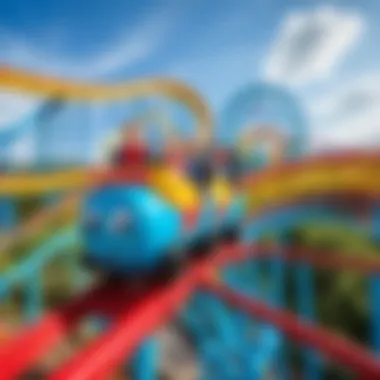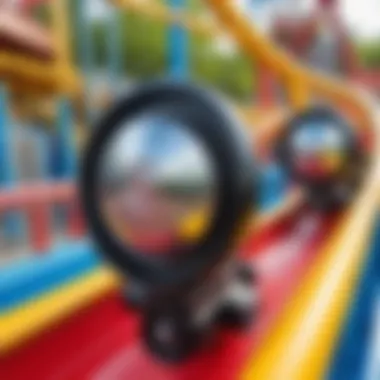Exploring Children's Roller Coasters: Design and Safety


Intro
Children's roller coasters hold a significant place in the realm of amusement parks. They are designed not only for excitement but for safety and accessibility for younger audiences. The intricate blend of design, psychology, and social dynamics creates a unique environment that caters to children and reassures parents. Understanding this landscape involves exploring various dimensions such as the structural elements of the coasters, the safety measures implemented, and the psychological effects these rides have on children.
Popular Trends
Unique Designs in Children's Coasters
A notable aspect of children's roller coasters is the unique designs that appeal to younger audiences. Many rides use bright colors and whimsical shapes. Designers often integrate themes from popular culture that resonate with children, like cartoon characters or natural environments. This connection helps enhance the emotional experience of the ride, making it memorable.
Comfortable Family Spaces
Amusement parks have evolved to prioritize comfortable areas for families. Children’s rides are typically located near family-friendly amenities. This includes shaded resting areas, nearby food options, and clean restrooms. These considerations not only improve the overall experience but also address parents' needs for convenience and comfort when enjoying their day out.
Preparing for the Experience
Tips for Choosing the Right Rides
Selecting the appropriate roller coaster for children can greatly impact their amusement park experience. Parents should assess height and weight restrictions as they vary from ride to ride. Additionally, it is essential to evaluate the overall intensity of the ride, as some may be too thrilling for younger children. Reading ride descriptions and seeking advice from park staff often provides helpful insight.
Packing Essentials for a Day at the Park
Preparing for a trip to an amusement park involves packing some essentials to ensure comfort and convenience. Here are some practical pointers:
- Sunscreen: Protects your children's skin from sunburn.
- Snacks: Keeps energy levels up; consider easy-to-carry options like granola bars.
- Water Bottles: Hydration is important, especially on warm days.
- Comfortable Footwear: Long hours of walking can be tiring, so shoes should be comfortable.
Preamble to Children's Roller Coasters
The subject of children's roller coasters is significant for various reasons. Not only do these attractions contribute to the overall experience of theme parks, but they also offer unique benefits and considerations for young audiences. In exploring this topic, it is crucial to understand how these rides are crafted to be engaging while ensuring safety for children. Parents, guardians, and park operators need to grasp the rationale behind the design elements and the importance of age-appropriate considerations.
The Evolution of Roller Coasters
Roller coasters have undergone a remarkable transformation since their inception. What began as wooden structures in the 18th century have developed into sophisticated rides, featuring steel tracks and advanced technology. Initially designed for older teens and adults, the evolution of roller coasters now includes dedicated versions for younger riders. This transition reflects a growing recognition of the need for accessible entertainment options that cater to the developmental stages of children.
The design of children's roller coasters often includes gentler slopes, lower heights, and minimal spins. Trends show a shift towards integrating more themes and educational components into the rides. Parks like Disneyland have led the way by introducing immersive experiences tailored specifically for younger audiences. The continued advancement in materials and engineering ensures that these rides maintain high safety and reliability standards, aligning with the evolving expectations of families visiting amusement parks.
Purpose and Importance
The purpose of children's roller coasters extends beyond mere entertainment. These attractions play a crucial role in helping children understand their own feelings about fear and exhilaration. They provide settings where children can safely explore adrenaline-inducing experiences. Moreover, roller coasters act as tools for parents to bond with their children while enjoying shared experiences. They help develop resilience in young riders by allowing them to confront challenges in a controlled environment.
Additionally, amusement parks often use children's roller coasters to create a sense of belonging among families. This is not just about fun; it is also about creating memories that last a lifetime. Recognizing these benefits adds depth to the understanding of the importance of children's roller coasters in theme parks. Their presence signifies a well-rounded entertainment experience, catering to children’s physical and emotional growth while understanding the fun associated with roller coaster rides.
"Children's roller coasters symbolize more than entertainment; they are gateways to growth and bonding within families."
In summary, the introduction of children's roller coasters warrants careful consideration, as it lays the foundation for future discussions on design characteristics, safety measures, and impacts on both children and their families.
Design Characteristics of Children's Roller Coasters
The design characteristics of children's roller coasters are critical to understanding their appeal and functionality. These coasters must provide thrilling experiences while ensuring the safety and comfort of young riders. Key elements in this design include size and scale, track layout, and features that cater to the intended age group. Effective design contributes to a positive impact on children's experiences in amusement parks. It creates a balance between enjoyment and safety, which is especially vital for younger audiences.
Size and Scale
Size and scale are fundamental aspects of children's roller coasters. These rides must be appropriately sized to match the physical and cognitive development of their target demographic. A smaller scale allows children to experience the thrill of roller coasters without overwhelming them with excessive speed or height. The compact designs of these rides encourage participation from a broader range of ages, promoting inclusivity.
Small coasters like the "Kid Coaster" often provide an ideal introduction to roller coasters for first-time riders. This careful sizing increases accessibility while ensuring that parents feel comfortable allowing their children to ride. Safety harnesses and appropriate seat sizes are also crucial features in these compact designs, further enhancing the overall experience.
Track Layout and Features
Track layout and features play a significant role in the ride experience. Unlike traditional roller coasters designed for older audiences, children's coasters often focus on smooth transitions and gradual changes in elevation. This design not only considers thrill but also guarantees safety.
Curves
Curves are a prominent feature in children's roller coasters. They provide smooth navigation around bends, making the ride enjoyable rather than jarring. The gentle nature of these curves allows children to anticipate movements, which reduces anxiety. Intuitively, these curves engage riders by encouraging interaction with the ride while remaining secure and stable. It is a beneficial design choice, as it can effectively keep children entertained with varied experiences throughout the ride.
- Key Characteristics of Curves:
- Smooth transitions that minimize abrupt movements.
- Encouragement of anticipation among young riders.


One unique feature of curves is their ability to create a sense of exploration. Kids feel like they are part of an adventure, which enhances the psychological aspect of the ride without compromising safety. However, too many tight curves can disorient younger riders, making it necessary to find a balance.
Hills
Hills are another hallmark of children's roller coasters. They create elevation changes that contribute to varying levels of excitement. Much like curves, the design of hills aims to be non-intimidating, offering gradual rises and drops. These gentle hills can evoke feelings of exhilaration without fear.
- Key Characteristics of Hills:
- Gradual increases in height to avoid intimidation.
- Create an experience of tension and release.
The unique feature that distinguishes these hills is how they provide thrills without overwhelming younger riders. Many children enjoy the feeling of going upwards before a mild drop. The challenge lies in ensuring that drops are not too extreme while providing enough excitement.
Twists
Twists add an additional layer of excitement to children's coasters. The incorporation of twists enhances the dynamic movement of the ride, stimulating interest. They encourage young riders to expect the unexpected, which can be thrilling and fun.
- Key Characteristics of Twists:
- Additive excitement through changing directions.
- Engage children's sense of curiosity and adventure.
However, careful design is necessary to ensure that twists are not too sharp or sudden. If executed poorly, this element can create discomfort for young riders. Nonetheless, when done correctly, twists can significantly enhance the overall experience.
Safety Regulations and Standards
When discussing children's roller coasters, safety regulations and standards emerge as a critical aspect. These protocols ensure the well-being of young riders, providing a framework that addresses the unique needs of children in amusement parks. Understanding these regulations can help parents and guardians feel secure about their children’s experiences while also shedding light on the responsibilities of operators.
Industry Safety Protocols
Industry safety protocols for children's roller coasters are stringent and designed to minimize risk while maximizing enjoyment. These protocols often stem from established organizations, such as the International Association of Amusement Parks and Attractions (IAAPA) and the American Society for Testing and Materials (ASTM). These regulations cover various areas, including structural integrity, operational procedures, and rider safety.
For example, operators must ensure that all rides undergo rigorous testing before opening to the public. This involves assessing the mechanical components, examining the track for any potential hazards, and evaluating the restraints used on the ride. Moreover, staff training plays a crucial role; operators are required to complete training programs that emphasize safety measures and emergency procedures.
Another important element is the adherence to age and height restrictions, which are based on thorough research into child development. It helps to ensure that rides are appropriate for their intended audience, thereby reducing the likelihood of accidents.
"Proper safety measures are not just about regulations, they are about ensuring memories are made in joy, not fear."
Inspection and Maintenance
Regular inspection and maintenance of children's roller coasters are vital for sustaining their safety and functionality. Such maintenance protocols are often mandated by local and national safety regulations and must occur at defined intervals. Trained inspectors conduct thorough checks, reviewing everything from the ride's mechanics to the physical integrity of the track.
Maintenance schedules typically include daily, weekly, and annual check-ups, allowing any problems to be quickly addressed. Daily checks might involve visual inspections of the ride, while more extensive evaluations occur on a weekly or monthly basis. Annual inspections usually consist of a detailed review conducted by certified professionals.
In addition, rides that experience higher volumes of usage may require more frequent inspections given the wear and tear associated with heavy traffic. It is the responsibility of operators to be diligent and proactive, ensuring that all aspects of the ride are secure.
Clearly, safety regulations and standards are not mere formalities; they are foundational to the trust placed in amusement park operators. The combined efforts of industry safety protocols and routine inspections create an environment where children can enjoy their roller coaster experiences, free from unnecessary risks.
Psychological Impact on Children
The psychological impact of children's roller coasters is a significant area of exploration in this article. Understanding how these rides affect young minds helps us comprehend their role beyond mere entertainment. Kids engage with roller coasters not only for the physical thrill but also for emotional experiences that contribute to their development. As they ride, children can encounter emotions from excitement to fear, shaping their understanding of their own capabilities and emotions.
Fear and Thrill Experiences
Fear is a complex emotion. In a controlled environment, roller coasters offer children a chance to confront and manage this fear. The sensation of plunging down steep hills or speeding through sharp turns can cause an adrenaline rush. Many children enjoy this feeling because it is safe. If they fall, it is not from a great height, and they are comfortably strapped in.
Experiencing thrill can help children identify and assess risks. It teaches them how to balance enjoyment with caution. Sometimes, parents express concern over the stress roller coasters may cause, but studies indicate that children are often more adept at coping with temporary fear than adults realize.
- Benefits of Fear Experiences:
- Teaches risk assessment
- Promotes emotional resilience
- Encourages social bonding through shared experiences
Coping Mechanisms
Children develop various coping mechanisms while riding these attractions. Understanding their responses can be essential for both parents and ride operators. Some children may scream, while others might laugh. These reactions are normal. They display individual differences in coping with excitement and fear.
Additionally, many young riders use strategies learned from their surroundings. For instance, a child watching an older sibling may learn to react calmly. Others might rely on breathing techniques to reduce anxiety before and during the ride.
- Common Coping Strategies Include:


- Deep breathing
- Positive self-talk
- Distraction techniques like focusing on the music or surroundings
Observing how children cope can provide insights for parents about their emotional growth and resilience. Overall, children's roller coasters play a significant role in emotional development by providing opportunities to experience and manage fear in a safe setting. The insights reveal that while thrill rides may seem purely fun, they possess layers of psychological impact that warrant acknowledgment.
Parental Perspectives
Parental perspectives play a pivotal role in the context of children's roller coasters. Understanding the viewpoints of parents and guardians reveals critical insights into the dynamics of family entertainment, safety, and children's experiences at amusement parks. This section addresses the benefits and considerations that shape parental views and influences on children’s experiences with roller coasters.
Safety Concerns
Safety concerns dominate the thoughts of many parents when considering children's experiences with roller coasters. The safety of rides is paramount for the peace of mind of parents. Statistics indicate that injuries can occur on amusement rides, causing significant worry for guardians.
- Age-appropriate design: Parents often look for coasters designed explicitly for younger audiences. This design usually includes lower heights, gentler drops, and secure restraints. Knowing that a ride is tailored to their children's age group helps alleviate concerns.
- Maintenance and inspections: Transparent communication about safety protocols can enhance parental confidence. Regular safety inspections, adherence to industry standards, and visible maintenance efforts can be reassuring for parents.
- Operator training: Parents feel more secure when staff members are well-trained. Observing trained operators in action can provide evidence of a safe environment for their children.
A survey by the International Association of Amusement Parks and Attractions shows that a significant number of parents prioritize safety when selecting amusements for their kids. It’s vital for amusement parks to communicate safety records and improvements effectively.
Family Bonding Opportunities
Beyond safety, children's roller coasters create opportunities for family bonding. Shared experiences can strengthen family ties and provide memorable moments that might last a lifetime. Parents often appreciate how these experiences foster connections between generations.
- Quality time: Going on roller coasters together can lead to shared laughter, excitement, and occasionally, a touch of fear. It's these moments that often become family stories told for years.
- Shared accomplishments: Overcoming fear is a growing experience for children. When a child conquers their fear of a ride with the support of a parent or sibling, it can enhance their self-esteem and create a sense of accomplishment. Families who face challenges together often emerge stronger.
- Engagement in decision making: Allowing children to choose which rides to experience can empower them. Engaging in discussions about preferences, fears, and expectations allows parents to validate their children's feelings while guiding them in a safe yet exhilarating environment.
In a rapidly evolving landscape of family entertainment, children's roller coasters are more than just rides. They are platforms for connection, highlighting the importance of understanding parental perspectives in the enjoyment and safety of amusement experiences. Engaging with families holistically can allow parks to provide a supportive and enriching environment.
"The joy of watching your child experience thrill for the first time is unmatched, and that moment cements family bonds while creating lasting memories."
Overall, recognizing the parental perspectives on safety and family bonding highlights the dual focus on providing a secure yet enjoyable environment for children.
Together, these factors play an essential role in shaping children's experiences and ultimately influence their enjoyment of amusement parks.
Entertainment vs. Education
The dialogue surrounding children's roller coasters often revolves around two significant elements: entertainment and education. This duality has become crucial in understanding the purpose these attractions serve. On one hand, they offer exhilarating thrills and joy, while on the other, they can provide valuable learning experiences. Recognizing this balance paves the way for a more comprehensive evaluation of children's roller coasters, influencing both design and user experience.
Learning Through Play
Play is a natural form of learning for children. Roller coasters can facilitate this engagement by incorporating elements that foster exploration and discovery. When children ride these attractions, they participate in an environment that encourages interaction with fundamental concepts of physics like speed, gravity, and inertia. The sensations brought by plunges and ascents can ignite curiosity, leading children to ponder why they experience specific feelings during rides.
Moreover, learning through play is not limited to theory. It encourages social interactions among children. As they go through these experiences together, they share thoughts and feelings, enhancing their communication skills. For many, the amusement park becomes a world in which collaboration and shared excitement create memories and friendships.
Conceptual Understanding of Motion and Physics
Children's roller coasters serve as practical applications of scientific principles. Concepts like acceleration and momentum are not merely discussed in a classroom setting; they become apparent as children feel the swift transitions and sudden drops while riding. Experiencing forces firsthand can demystify these abstract concepts, allowing children to develop a better grasp of motion and its mechanics.
Incorporating educational elements into the design of these rides can further enhance the learning experience. For instance, some parks creatively employ signage or interactive displays that explain the physics behind roller coasters. This approach turns amusement into an educational journey, allowing children to connect fun experiences with real-world knowledge.
"Education can be found in the most unexpected places. When entertainment aligns with learning, the possibilities for growth are limitless."
Understanding how children's roller coasters contribute to both entertainment and education is essential for parents and designers. This knowledge can help shape future innovations in amusement park attractions while fulfilling the needs of young audiences.
Trends in Children's Roller Coasters
Tendencies in the design and operation of children's roller coasters reflect broader developments in the amusement industry. These trends are crucial not only for enhancing the visitor experience but also for meeting evolving consumer expectations. New designs prioritize safety, comfort, and engagement of children in a way that is suitable for various age groups. Staying aware of these trends is vital for amusement parks to remain competitive and relevant.
Innovative Designs
Innovative designs in children's roller coasters focus on creativity and safety. Parks are adapting their offerings to attract families seeking unique experiences. For instance, coasters are increasingly incorporating interactive elements. This means rides that engage children during the experience, rather than simply providing a thrilling drop.
One significant trend is the use of bright colors and fantastical themes. Coasters themed around popular children's characters capture attention and create a recognizable atmosphere. Additionally, the scale of the rides is being carefully adjusted. Modern coasters are often smaller and lower to the ground. This allows younger children to experience the thrill without feeling overwhelmed.
Moreover, incorporating gentle curves and moderate speed helps to ensure that the ride remains fun. Enthusiasm for innovative layouts that include spinning cars or light effects adds an exciting layer. As a result, parks are not just putting together rides; they are creating immersive environments.
"Families prefer experiences that are visually appealing and safe. The design must meet both criteria to be successful."
The Role of Technology
Technology plays a significant role in shaping children's roller coasters. Integration of modern advancements enhances safety and user experience. Many parks are now utilizing smart technologies to monitor ride performance in real-time. Sensors can detect stress levels on rides, ensuring that they operate within safe parameters.
Another aspect of technology’s role involves the use of apps for ride management. Parks have adopted systems that allow families to reserve their spots, thus reducing wait times. Line management technologies enhance the overall guest experience, making visits more enjoyable.


Virtual reality is now being explored in some of the newer rides. It provides an illusion of speed and excitement without the physical risks associated with traditional high-speed coasters. By allowing children to engage in imaginative scenarios, parks can offer diverse experiences that focus on thrill and fun rather than just physical excitement.
In summary, trends in children's roller coasters are guiding the future of amusement park design, with a dual focus on safety and engaging experiences. These innovations reflect a deeper understanding of children's needs and preferences, paving the way for inclusive, memorable family outings.
Cultural Influence and Acceptance
The topic of cultural influence and acceptance is fundamental in understanding how children's roller coasters fit into the broader entertainment landscape. Different cultures have contrasting views on amusement rides, which in turn shapes their design and operation. Recognizing this can lead to better insights into why certain themes or features are favored in specific regions.
Cultural influences can dictate not just the aesthetics of roller coasters, but also their safety protocols. For instance, in regions where thrill-seeking behaviors are encouraged, coasters may be designed with more extreme features and larger heights. Conversely, in cultures that emphasize caution or safety, you may find simpler designs emphasizing safety elements, with smoother transitions and limited heights.
Some benefits of understanding cultural influence include:
- Tailoring experiences to fit local expectations.
- Enhancing the accessibility of rides for diverse audiences.
- Creating an inclusive environment welcoming various cultural perspectives.
It is essential to consider how children's roller coasters contribute to family bonding and entertainment. Communities often gather around local amusement parks, fostering social connections. Thus, acceptance can create a shared experience which is significant in many cultures.
Regional Variations in Design
Regional variations in the design of children's roller coasters reflect the cultural nuances and preferences of each area. For example, in parts of Europe, you will often find coasters that emphasize historical themes, intertwining local folklore into their rides. In contrast, North America tends to lean towards innovation and technology, providing more high-tech experiences that incorporate virtual reality.
Other considerations include:
- Age Appropriateness: In some cultures, there is a greater emphasis on ensuring that rides are suitable for young children, leading to lower height restrictions.
- Safety Standards: Different regions have varied safety regulations, affecting coaster designs, especially regarding harness systems and ride heights.
These variations illustrate how local culture can shape the roller coaster experience, making it unique to its environment.
Public Perception of Roller Coasters
Public perception of roller coasters plays a significant role in their acceptance. In many communities, these rides are seen as rites of passage for children, contributing to personal growth and family memories. This positive perception can enhance visits to amusement parks, making them significant for parents and children alike.
However, there are dissenting voices. Some people raise concerns regarding safety and health issues, especially in regions where accidents have occurred. Here are some points to consider regarding public perception:
- Safety Concerns: Many parents worry about the safety of their children on roller coasters. Public opinion can shift rapidly based on incidents or reports.
- Cultural Norms: In some cultures, rides are embraced as essential family entertainment, while in others, they may be perceived as risky or unnecessary.
Understanding public perception is crucial for amusement parks. Successful parks adapt by responding to local sentiments, ensuring their attractions cater to the opinions and preferences of the community.
In all, cultural influence and public acceptance are crucial for the development and ongoing popularity of children's roller coasters. By navigating these areas suitably, amusement parks can continue evolving to meet the diverse needs of their young audiences.
Environmental Considerations
The discussion around children's roller coasters must engage with the concept of environmental considerations. This includes the timeline of how these attractions interact with nature and urban settings. As theme parks grow, so do their responsibilities towards sustainable practices. Roller coasters, while primarily designed for thrill and joy, often risk negative impacts on local ecosystems and communities. Understanding these dynamics is crucial for stakeholders who seek to create attractions that are both fun and environmentally responsible.
Sustainability in Design and Operations
The push for sustainability in design reflects a growing awareness among operators and designers of children's roller coasters. Sustainable design means using materials and processes that minimize environmental harm. Designers are now considering how they can reduce their carbon footprint.
One notable shift is the choice of materials. Eco-friendly options like bamboo and recycled metals are gaining traction. These materials are often more durable than traditional ones and have less impact on the environment. Additionally, many parks are investing in renewable energy sources. Solar panels on-site play an important role in powering amusement rides, thus cutting reliance on fossil fuels.
Another aspect of sustainability is water management. Effective systems for water reuse help lessen the strain on local water supplies. Proper drainage systems also prevent water runoff that can lead to soil erosion and habitat destruction.
Impact of Climate on Outdoor Rides
Climate can significantly affect the operation and safety of outdoor children's roller coasters. High temperatures can lead to materials expanding, which may affect track stability. Conversely, during colder months, freezing conditions can create hazards like frost on surfaces.
Moreover, climate change poses longer-term challenges for theme parks. Increased rainfall and severe weather events can impact park operations and visitor safety. For example, heavy storms might necessitate the temporary closure of rides, which affects revenue. Parks must then adapt their facilities with robust design strategies to withstand these challenges.
In summary, the relationship between children's roller coasters and environmental considerations is complex yet crucial. A balance must be struck between providing thrilling experiences and ensuring sustainability. Integrating sustainable designs can also enhance public perception and draw in eco-conscious guests.
Closure
In this article, the significance of children's roller coasters is discussed from various angles including design, safety, psychological factors, and trends. The conclusion consolidates the insights gained throughout. Children’s roller coasters are more than just amusement rides; they are vital components of childhood experiences. These attractions offer children their first taste of thrill, which can shape their understanding of fear and excitement.
Future of Children's Roller Coasters
The future of children's roller coasters is poised for unique developments as technology and design methods continue to evolve. Manufacturers are actively incorporating safety features that adapt to the growing understanding of child psychology. This is not just about fun, but also about designing experiences that promote comfort and excitement.
Furthermore, innovation is critical. Attractions are expected to feature more engaging themes, interactive elements, and educational concepts. The demand for rides that are versatile and can cater to different age groups is becoming more apparent.
"The landscape of children's roller coasters will continue to evolve to meet the expectations of both children and their parents."
Environmental sustainability is also gaining traction in the amusement industry. Future designs will likely emphasize sustainable materials and energy-efficient operations to minimize ecological impacts.
In summary, the future of children's roller coasters holds great potential. It is essential to respond to changing societal needs and interests. The integration of safety, education, and environmental consciousness will guide the next generation of attractions in a way that resonates with young audiences and their families.







